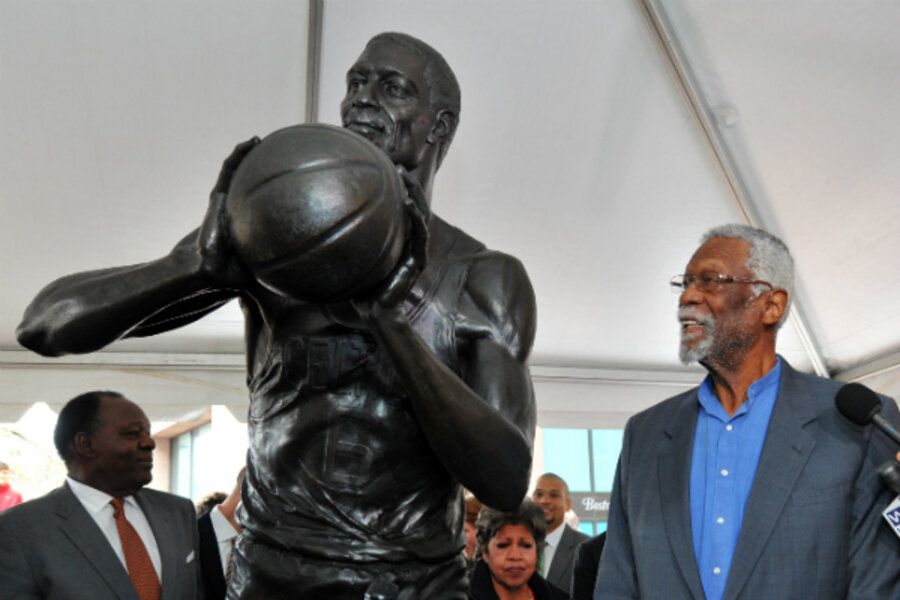Basketball's Bill Russell joins the Bronze Age
Loading...
| BOSTON
Championship parades in Boston have become almost as common as, well, the Boston Common. Finally, though, Bill Russell, the athlete whose name became synonymous with championships in the 1950s and ’60s, has been immortalized with a bronze statue at the heart of the Hub – on City Hall Plaza.
The ceremony took place Friday before a host of former players and VIPs, everyone from athletic greats Jim Brown and Julius Erving, to singer Johnny Mathis and former teammates Sam Jones, Tommy Heinsohn, and Satch Sanders to Boston’s outgoing mayor, Tom Menino, who worked closely with the Celtics’ Shamrock Foundation to make the tribute possible.
There’s a sweet irony to the statue’s placement for Russell, whose relationship with the city while leading the Celtics to 11 NBA championships in 13 years was strained by racial tensions. In 1976, well after Russell’s departure from the city, a Pulitzer Prize-winning photograph was snapped on the plaza of a white male using an American flag to attack a black man during an anti-busing demonstration.
In 1972, the Celtics raised Russell’s jersey No. 6 to the Boston Garden rafters, but at his request it was a private ceremony because he didn’t care to share it with the public. Over the years, though, a rapprochement has occurred with the city and its fans, and in 1999 Russell consented to a pubic redo of the banner-raising ceremony before a packed house. The love-in has been in full swing ever since.
The 8-foot-tall statue, many fans would say, is long overdue for a player whose championship credentials far exceed those of any other Boston superstar. Even if you add up the championship teams other past and current greats have led (Ted Williams, 0; Bobby Orr, 1; Larry Bird, 3; Tom Brady, 3, and now David “Big Papi” Ortiz, 3), you still come up one shy of Russell’s lofty total.
The Russell statue, in which his playing likeness anchors outlying, inscribed granite blocks meant to represent his championships, is sited across the street from a statue of his Celtic coach, Red Auerbach. Despite their personal dissimilarities, the two men hit it off so well that in 2010, Russell wrote a rembrance titled, “Red and Me: My Coach, My Lifelong Friend.”
Auerbach’s statue at the historic Fanueil Hall Marketplace popular with tourists, shows him sitting alone on the Celtics bench, smoking one his famous victory cigars. The pose selected by sculptor Ann Hirsch for the Russell statue shows him making a chest pass, which is meant to symbolize the Hall of Famer’s unselfish play and desire to pass the mantle of athletic excellence and leadership to future generations. Mentorship of youth has been one of Russell’s personal passions.
According to the Boston Globe, Ms. Hirsch developed such a deep commitment to this project that she flew to the West Coast just to have lunch with Russell at his home near Seattle. The get-acquainted visit turned into a nine-hour conversation that she described as “the most amazing day of my life.
”“All I’ve ever done is live every day like my father,” Russell said at the unveiling.
The Russell statue is part of the national trend to cast sports heroes in bronze for posterity. The St. Louis Cardinals, alone, have 11 former greats honored in this way. Boston has been more measured in this regard.
Here’s the rest of the city’s lineup of public sports statues and plaques, in chronological order:
1995
Johnny Kelly: The local distance-running legend who won the Boston Marathon twice (in 1935 and ’45), finished second a record seven times, and finished the race 58 of the 61 times he ran it. The statue at the base of “Heartbreak Hill” on the marathon course shows a twentysomething Kelly running hand-in-hand with his octogenarian self.
1998
Larry Bird: Plaque with a pair of his bronzed size-13-1/2 sneakers and a list of his basketball accolades is embedded in the brick plaza at Fanueil Hall Marketplace. (There is a 15-foot-tall statue of Bird, dedicated this year, on Indiana State University campus, his alma mater.)
2000
Bill Rodgers: A bronze Fanueil Hall Marketplace plaque with a pair of his running shoes was created to honor “Boston Billy, who won both the Boston and New York City marathons four times each between 1975 and 1980.
2004
Ted Williams: Outside Fenway Park’s right field entrance, a statue depicts Williams placing a cap on the head of a young boy who is battling cancer. Williams long supported the work of the Jimmy Fund Clinic of the Dana Farber Cancer Institute.
2010
Bobby Orr: The statue outside TD Garden shows Orr as he appears in a famous photograph taken of him flying through the air after scoring the overtime goal against the St. Louis Blues that clinched the 1970Stanley Cup for the Boston Bruins. It was the team’s first championship in 29 years.
Red Sox teammates Ted Williams, Dom DiMaggio, Bobby Doerr, and Johnny Pesky. The four-figure statue, erected outside Fenway Park’s right field entrance, was inspired by David Halberstam’s 2003 book, “Teammates: A Portrait of a Friendship,” which chronicles the decades-long friendship of the Boston Red Sox stars whose careers overlapped in the 1940s and ’50s.







